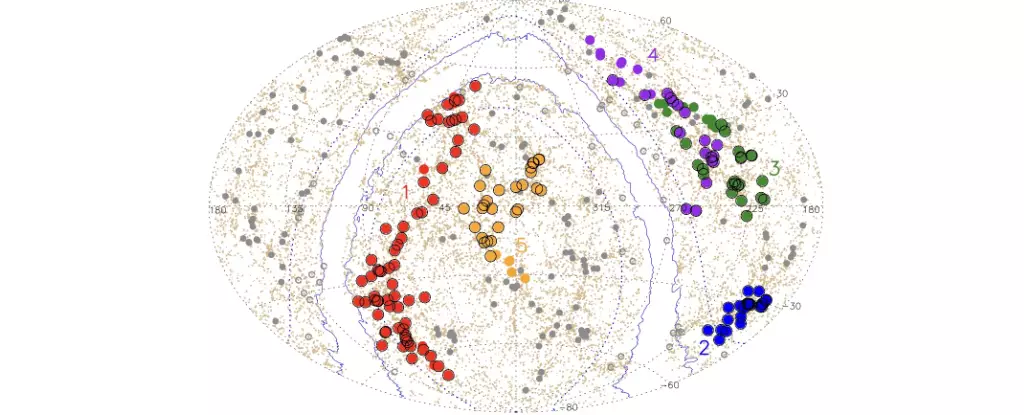The quest to comprehend our Universe often leads astronomers to consider its largest structures. This is not merely an intellectual exercise; it affects our fundamental understanding of cosmic evolution and dynamics. Recent discoveries have emphasized that to effectively comprehend the cosmos, we cannot overlook the implications of these vast entities. For instance, one of the most significant contributions to our understanding is the identification of Quipu—a colossal superstructure that showcases the intricate web of gravitational forces and cosmic matter.
Quipu, conceived after an Incan system of measurement composed of knotted cords, holds staggering statistics: it weighs around 200 quadrillion solar masses. This extraordinary mass hints at a structure so immense that its very existence shapes the Universe around it. Astronomers classify it as a superstructure due to its extensive reach, stretching over 400 megaparsecs or more than 1.3 billion light-years. Such enormity raises pivotal questions about the fundamental principles that govern cosmic evolution and how they impact other celestial phenomena.
Understanding structures like Quipu isn’t a mere academic endeavor; they serve as vital keys to unraveling the mechanics of the cosmos. The recent research titled “Unveiling the largest structures in the nearby Universe: Discovery of the Quipu superstructure,” led by Hans Bohringer from the Max Planck Institute, underscores how critically we need to analyze these types of models for accurate cosmological measurements. Specifically, their effects can modify the Cosmic Microwave Background (CMB)—the afterglow of the Big Bang—introducing nuances that can complicate our theoretical models.
The research outlines the necessity of understanding local large-scale structures, noting how gravity fields from such mass distort cosmic observations. This includes effects on the CMB, where fluctuations can lead to erroneous interpretations of cosmological parameters. Moreover, the motion of galaxies, influenced by nearby superstructures, can further obscure our measurements related to the Hubble constant, critical in assessing the Universe’s expansion rate. In a Universe where observational errors can often lead to miscalculations, understanding these superstructures’ roles becomes essential.
The identification of Quipu was achieved through sophisticated analysis of X-ray emissions from galaxy clusters. The Cosmic Large-Scale Structure in X-rays (CLASSIX) survey exploited this method to pinpoint superstructures and their properties. The remarkable ability of X-ray astronomy to reveal intricate details about the concentrations of matter allows astronomers to map the cosmic web with ever-increasing precision.
The study also aligns Quipu with other discovered superstructures, which collectively represent a staggering portion of the Universe’s matter and galaxy clusters. According to the findings, these structures contain approximately 45% of galaxy clusters, 30% of all galaxies, and 25% of the Universe’s total matter. This massive centralization signifies their indispensable role in shaping the cosmic landscape.
However, the presence of superstructures like Quipu poses both opportunities and challenges for astronomers. While they serve as valuable research avenues, they simultaneously introduce considerable complexities into observational data. For example, larger structures can distort light from background objects through gravitational lensing, making it difficult to interpret those measurements accurately.
In addition to distorting observations, these massive entities leave an imprint on the CMB. This imprint is not trivial—the Integrated Sachs-Wolfe effect leads to fluctuations that require precise filtering to isolate the true signal from cosmic events. The challenge lies in reconciling these variations with our theoretical understanding of how structures form and evolve over cosmic time.
Notably, although structures like Quipu are monumental, the study suggests their existence is not permanent. As the Universe evolves, these enormous conglomerates are likely to fragment into smaller, collapsing units. This transient nature further complicates our understanding of cosmic evolution, as it challenges us to grasp a constantly shifting paradigm.
Bohringer and his colleagues acknowledged the need for ongoing research, especially in assessing how superstructures influence galaxy evolution and distribution within their environs. The transient essence of these formations underlines their dynamic role in the Universe’s fabric, prompting questions about how local environments shape galactic life.
The significance of studying superstructures like Quipu cannot be overstated. They challenge prevailing cosmological models and offer insights crucial for advancing our understanding of the Universe. As we develop more sophisticated methods to examine these structures, we uncover deeper layers of the cosmic tapestry. This exploration promises not only to clarify our existing models but also to enrich our cosmic narrative, ultimately bringing us closer to deciphering the mysteries of the Universe at large. The journey is fraught with complexities, but every discovery offers a potential breakthrough in our understanding of the cosmos.


Leave a Reply